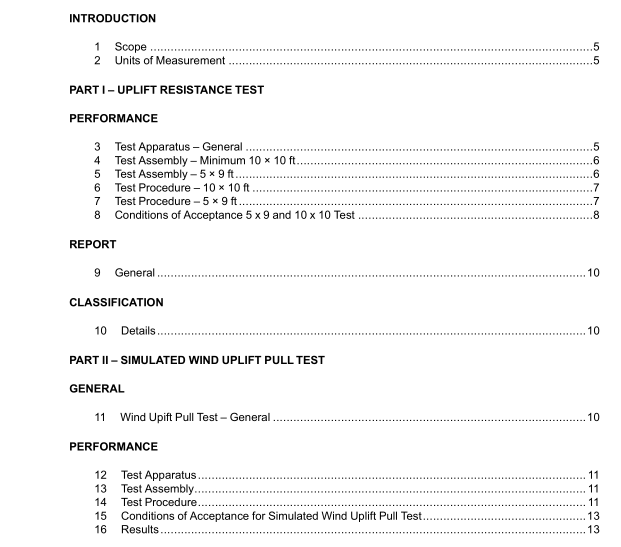UL 1897:2020 free download STANDARD FOR SAFETY Uplift Tests for Roof Covering Systems
3.4 When underside uniform static positive pressure is utilized in combination with topside uniform static negative pressure the total differential pressure across the assembly is to be measured as well as the corresponding pressures developed within the bottom and the top chambers.
3.5 Recording equipment is to be used to make a permanent record of the pressure levels developed in the test.
4 Test Assembly – Minimum 10 × 10 ft
4.1 The roof system test assembly is to be representative as to materials, workmanship, and details such as dimensions of parts of the roof deck construction for the rating desired. It shall be built in accordance with the system installation specifications under conditions representative of those in building construction under normal field conditions of use. Properties of the materials and ingredients used in the test assembly, together with their location and method of attachment, are to be determined and recorded.
4.2 The dimensions of the test assembly are to be a minimum of 10 by 10 ft (3.05 by 3.05 m). The test assembly shall contain side and end joints if such occur in field installation, which represent the most vulnerable exposure to uplift due to wind conditions. Test assemblies that utilize mechanically-attached membranes are to be of sufficient size to incorporate a minimum of three batten or fastener rows plus an additional 1-ft ( 0.305-m) minimum outside the outlying batten or fastener rows. The test assembly shall consist of secondary bearing members, such as purlins and joists, to which the roof decking is fastened. The assembly components, including secondary members, are to be located to best simulate field conditions, such as maximum span and maximum attachment spacing.
4.3 The periphery of the roofing system test assembly is to be sealed so as to permit the development of a sustained static pressure differential.
4.4 Polyethylene film shall be permitted to seal joints or other air-permeable portions within roof systems when necessary to attain test pressures. The film shall be applied loosely with longitudinal pleats that are positioned up into ribs and/or with extra folds such that the film follows the contour of the assemblies under test. Use of the plastic film shall not prohibit transfer of the full load to the assembly, shall not prevent full movement, or otherwise adversely impact test results.
4.5 The test assembly is to be cured at room temperature until the field strength, humidity, and temperature as specified by the manufacturer are achieved. Hot-mopped or torch applied bitumen roof coverings are to be tested after reaching an ambient room temperature.
4.6 The test specimen frame, containing the installed roof assembly, is placed on the pressure vessel and is sealed by a gasket located between the top of the pressure vessel and the bottom of the test specimen frame. Contact between the pressure vessel and the test sample frame is made at the perimeter.
5 Test Assembly – 5 × 9 ft
5.1 The 5 × 9 Wind Uplift Test Procedure shall be permitted to be used to evaluate various types of roof assemblies in accordance with (a) – (f). The Simulated Wind Uplift Resistance Rating obtained using this procedure shall be limited to a maximum of 90 lbs/ft 2 (4.3 kPa):
a) Mechanically-attached and spot welded membranes are to be of sufficient size to incorporate a minimum of three batten or fastener rows The batten or fastener row spacing shall not be in excess of 4-ft (1.2-m) on center. The batten or fastener rows shall be oriented parallel to the 5-ft (1.5-m) width of the chamber. The batten or fastener rows shall incorporate a minimum of three fasteners per row and shall not be in excess of 2-ft (0.6-m) on center.
UL 1897:2020 free download
